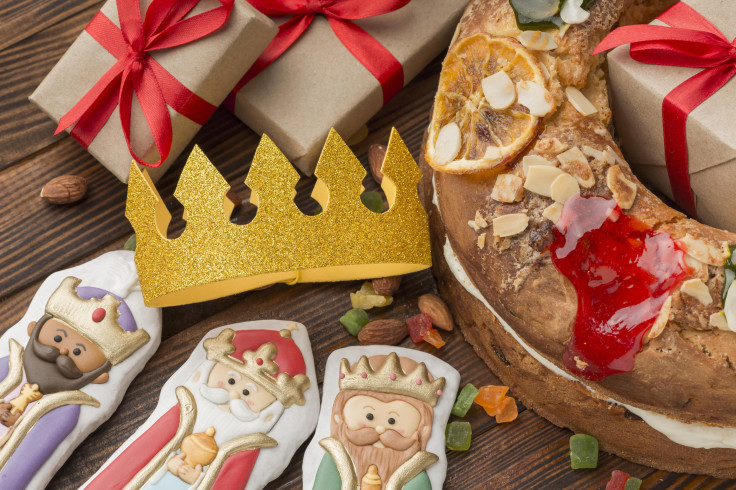
As the holiday season wraps up in many U.S. households, the best is yet to come in some other parts of the world—especially if you're a Latino kid as January brings a special celebration known as 'Día de los Reyes Magos', or 'Three Kings Day'.
January 6th is rich in traditions, gift-giving, and stories of tired camels searching for some fresh grass. It is a significant event in many Latino communities, but what exactly is 'Three Kings Day' and how is it celebrated?"
In essence, 'Día de los Reyes Magos,' commemorates the day in which the three wise men arrived with gifts for newborn Jesus, in accordance with Christian traditions.
Their offerings of gold, frankincense, and myrrh have evolved into a tradition of gift-giving, especially for children. After Santa's coming down of the chimney, Latino kids eagerly await the arrival of three magi riding camels from a distant land.
In the United States, many cities with big Latino communities, such as New York City or San Antonio, Texas, will see special parades where the three wise men - Melchior, Caspar, and Balthazar- will be represented.
What is 'Día de Los Reyes'?
Celebrated by Roman Catholics on January 6, 'Three Kings Day,' or 'Día de los Reyes Magos,' marks the culmination of the 12 days of Christmas. While the birth of Jesus is commemorated on Christmas Day, according to biblical accounts, the three kings didn't actually reach him until twelve days later.
According to Christian traditions, Melchior hailed from Europe, as characterized by a long white beard. Caspar, residing in Asia, was distinguished by brown hair and beard, while Balthazar, of African descent, had a black complexion.
Despite being strangers, their paths converged as they followed a guiding star, leading them to the city of Bethlehem on January 6. It was there that they presented their symbolic offerings to the newborn Jesus.
How is 'Día de Los Reyes' Celebrated Around the World?
'Día de Los Reyes' is observed not only in Spanish-speaking countries like Mexico and Spain but also in various other countries across Latin America, the Caribbean, France, Poland, and by certain Latino communities in the United States.
On the night of January 5, Latino children place their shoes, along with grass and water -or other treats-, under their beds or at the entrance of their homes for the camels of the Three Kings. At the break of dawn children rise early to discover the gifts left for them in their shoes by the Three Kings.
Today, most Latino families observe both Christmas and Three Kings Day, offering substantial gifts on the first holiday and smaller gifts on the second.
'Rosca de Reyes': What is this 'Día de Los Reyes' Treat?
Rosca de Reyes is a special bread with fruit and sugar that comes in the shape of an oval to represent a crown. Candied figs and cherries symbolize the crown jewels.
In some Latino communities, it has become tradition to place a tiny plastic baby inside the 'rosca de reyes,' representing the newborn messiah. Customarily, in some Mexican households, the person who discovers the baby in their slice is tasked with preparing tamales for everyone on February 2, Candelaria Day.
'Día de Los Reyes' 2024: How Will it be Celebrated in the U.S. this year?
A Three Kings Day parade (Fiesta de los Reyes Magos) is happening in Washington D.C. at the GALA Hispanic Theatre on Jan. 7 at 2 p.m. A procession of the Kings and live animals will make their way around the block with a street parade, local musicians and dance troupes. Free gifts will be given out to children.
Announcing new details for our 47th annual Three Kings Day Parade on Friday, January 5! We can’t wait to celebrate with you. Visit https://t.co/5OndxN4AAS for the latest info. pic.twitter.com/A9otiUbX7z
— El Museo del Barrio (@elmuseo) December 29, 2023
In New York City, 'El Museo del Barrio' will present the 47th Annual Three Kings Day Parade and Celebration on Friday, January 5th. The parade will begin at 11am at 106th Street and Park Avenue and end at 12pm on 115th Street and Park Avenue, featuring camels, floats, live music, and thousands of participants. The event will include a live musical performance in El Teatro from 1:30-3pm.
In San Antonio, Texas, the Puerto Rican Heritage Society will host its 'Three Kings Day Celebration' on Sunday, January 7, 2024 from noon to 4 p.m. at San Fernando Hall, located at 231 W. Commerce. The last time this event was held publicly in our community was in 2020.
The event will be free and open to the public. Families who attend the celebration will get a photo opportunity with the Three Kings — Melchior, Caspar and Balthazar. There will also be arts and crafts for children, music and food for sale by a local Puerto Rican restaurant.
© 2025 Latin Times. All rights reserved. Do not reproduce without permission.





